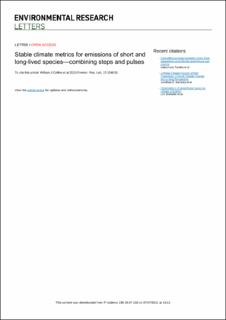| dc.contributor.author | Collins, William J. | |
| dc.contributor.author | Frame, David J. | |
| dc.contributor.author | Fuglestvedt, Jan S. | |
| dc.contributor.author | Shine, Keith Peter | |
| dc.date.accessioned | 2021-07-14T11:38:40Z | |
| dc.date.available | 2021-07-14T11:38:40Z | |
| dc.date.created | 2020-07-21T11:34:43Z | |
| dc.date.issued | 2020 | |
| dc.identifier.citation | Environmental Research Letters. 2020, 15 (2), . | en_US |
| dc.identifier.issn | 1748-9326 | |
| dc.identifier.uri | https://hdl.handle.net/11250/2764406 | |
| dc.description.abstract | Multi-gas climate agreements rely on a methodology (widely referred to as 'metrics') to place emissions of different gases on a CO2-equivalent scale. There has been an ongoing debate on the extent to which existing metrics serve current climate policy. Endpoint metrics (such as global temperature change potential GTP) are the most closely related to policy goals based on temperature limits (such as Article 2 of the Paris Agreement). However, for short-lived climate forcers (SLCFs), endpoint metrics vary strongly with time horizon making them difficult to apply in practical situations. We show how combining endpoint metrics for a step change in SLCF emissions with a pulse emission of CO2 leads to an endpoint metric that only varies slowly over time horizons of interest. We therefore suggest that these combined step-pulse metrics (denoted combined global warming potential CGWP and combined global temperature change potential CGTP) can be a useful way to include short and long-lived species in the same basket in policy applications—this assumes a single basket approach is preferred by policy makers. The advantage of a combined step-pulse metric for SLCFs is that for species with a lifetime less than 20 years a single time horizon of around 75 years can cover the range of timescales appropriate to the Paris Agreement. These metrics build on recent work using the traditional global warming potential (GWP) metric in a new way, called GWP*. We show how the GWP* relates to CGWP and CGTP and that it systematically underestimates the temperature effects of SLCFs by up to 20%. These step-pulse metrics are all more appropriate than the conventional GWP for comparing the relative contributions of different species to future temperature targets and for SLCFs they are much less dependent on time horizon than GTP. | en_US |
| dc.language.iso | eng | en_US |
| dc.rights | Navngivelse 4.0 Internasjonal | * |
| dc.rights.uri | http://creativecommons.org/licenses/by/4.0/deed.no | * |
| dc.title | Stable climate metrics for emissions of short and long-lived species—combining steps and pulses | en_US |
| dc.type | Journal article | en_US |
| dc.type | Peer reviewed | en_US |
| dc.description.version | publishedVersion | en_US |
| dc.source.pagenumber | 0 | en_US |
| dc.source.volume | 15 | en_US |
| dc.source.journal | Environmental Research Letters | en_US |
| dc.source.issue | 2 | en_US |
| dc.identifier.doi | 10.1088/1748-9326/ab6039 | |
| dc.identifier.cristin | 1820005 | |
| cristin.ispublished | true | |
| cristin.fulltext | original | |
| cristin.qualitycode | 2 | |

